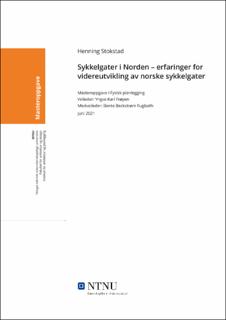| dc.contributor.advisor | Frøyen, Yngve Karl | |
| dc.contributor.advisor | Fuglseth, Bente Beckstrøm | |
| dc.contributor.author | Stokstad, Henning | |
| dc.date.accessioned | 2021-10-21T18:10:10Z | |
| dc.date.available | 2021-10-21T18:10:10Z | |
| dc.date.issued | 2021 | |
| dc.identifier | no.ntnu:inspera:85482393:52046043 | |
| dc.identifier.uri | https://hdl.handle.net/11250/2824636 | |
| dc.description.abstract | Nasjonal transportplan 2022-2033 har ambisiøse mål for sykkelandelene i Norge. For å øke sykkelomfanget blir sammenhengende sykkelnett trukket frem som et effektivt virkemiddel i flere studier. Sykkelnettet i Oslo består av byruter med ulike sykkelløsninger som er tilpasset de lokale forholdene langs ruten. Sykkelgate er et eksempel på en slik løsning der Oslo kommune har utviklet sin egen versjon. Denne skiller seg fra den nasjonale gatenormalen ved at biltrafikk tillates. Sykkelgater med biltrafikk er derimot utbredt i Europa. Nabolandene i Norden har nylig innført både skilt og ferdselsregler for sykkelgate i sin lovgivning, men det er uavklart om Norge skal gjøre det samme.
Denne studien kommer med anbefalinger til hvordan norske sykkelgater kan videreutvikles, basert på praksis og erfaringer med sykkelgater i Europa. Hovedfokuset er på de nordiske landene; Danmark, Sverige, Finland og Norge. Blant metodene i oppgaven er et dokumentstudium benyttet for innsamling og analyse av empiriske data om sykkelgater. Bruk og utforming av fire nordiske sykkelgater er undersøkt i en komparativ casestudie. Informantsamtaler med representanter fra veimyndighetene i de nordiske landene ble benyttet for å undersøke hvorfor og hvordan sykkelgater ble innført i lovgivningen.
Funnene i oppgaven er grunnlaget for anbefalingene til videreutvikling av norske sykkelgater. Kort oppsummert er disse at Norge bør innføre et soneskilt for sykkelgate med særskilte ferdselsregler. Det bør tillates biltrafikk og forkjørsregulering, men ikke busstrafikk. Parkering bør kun skje på tydelig avmerkede plasser og hastigheten i gaten bør være 30 km/t eller lavere. Utformingen av gaten bør bidra til å fremme ønsket adferd, og det bør komme tydelig frem at det er en sykkelgate. Videre bør sykkelgater etableres der det er et potensiale for et stort sykkelvolum, og der syklistene er, eller kan bli den dominerende trafikantgruppen.
Ved å innføre sykkelgate med biltrafikk utvides verktøykassen til norske planleggere. Løsningen er arealgjerrig, og kan skape tilrettelegging for sykling i blandet trafikk og sammenhengende sykkelruter. Sykkelgate med biltrafikk kan derfor bli et viktig virkemiddel for å nå de ambisiøse målsetningene i Nasjonal transportplan. | |
| dc.description.abstract | Nasjonal transport plan 2022-2033 features ambitious goals for Norwegian scope of bicycle traffic. Interconnected cycling networks are highlighted in several studies as effective means to increase the scope of bicycle traffic. The cycling network of Oslo consists of city routes with various cycling solutions tailored to the local environments. Bicycle boulevard are an example of these solutions with the municipality of Oslo having developed its own model. The model deviates from the national street standard as it allows for both cycling and motorized traffic. Bicycle boulevards that include motorized traffic is on the other hand more widespread in many other European countries. The neighboring Nordic countries of Norway have recently introduced new traffic signs and regulations for bicycle boulevards. Presently it is unclear whether Norway will do the same.
This study presents recommendations to the further development of Norwegian bicycle boulevards based on experiences from other European countries. The study mainly concerns itself with the Nordic countries; Denmark, Sweden, Finland and Norway. The paper includes a documentative study used to collect and analyze empirical data about bicycle boulevards. Also, the use and design of four Nordic bicycle boulevards have been researched in a comparative case study. Conversations with informants and representatives from road authorities in the Nordic countries has been used to survey why and how bicycle boulevards were included in the legislation.
The finds presented in this paper constitute the basis of the recommendations to the further development of Norwegian bicycle boulevards. In short, these recommendations propose that Norway should introduce a sign that designates bicycle boulevards which features separate traffic rules. Motorized traffic and regulations for right of way should be allowed, but bus traffic should be excluded. Parking should only take place where there are notable markings for parking spaces and the speed limit should not exceed 30 kmph. The design of the street should invite road-users to follow desired behavior and it should be made apparent that the street is a bicycle boulevard. Furthermore, bicycle boulevards should be set up where there is a potential for high volumes of bicycle traffic, and where cyclists are – or may become – the dominant traffic group.
Introducing bicycle boulevards that allows for motorized traffic will augment the tool kits of Norwegian traffic planners. The solution is efficient with respect to area and may promote cycling in mixed traffic and advance the development of interconnected cycling networks. For these reasons, bicycle boulevards with motorized traffic may become an important means to realize the ambitious goals included in Nasjonal transport plan. | |
| dc.language | nob | |
| dc.publisher | NTNU | |
| dc.title | Sykkelgater i Norden – erfaringer for videreutvikling av norske sykkelgater | |
| dc.type | Master thesis | |
